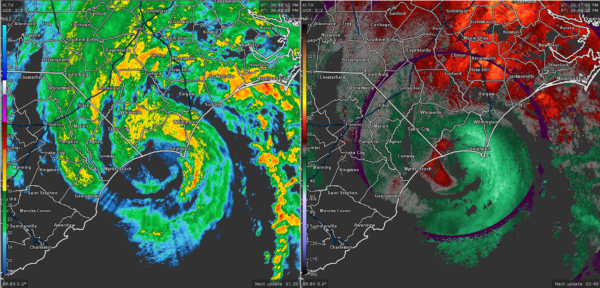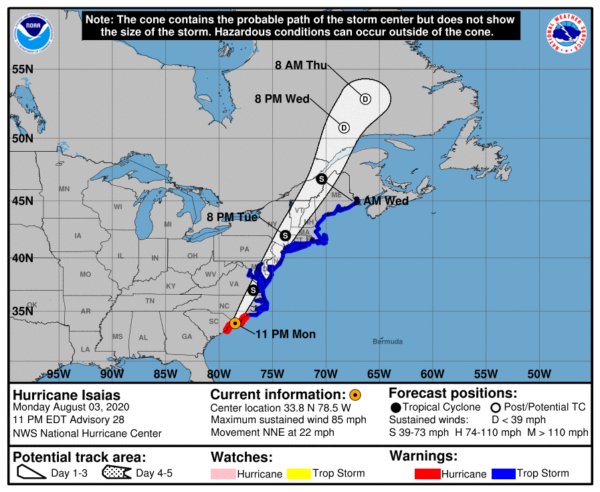Isaias Continues to Strengthen as the Eye is Now Moving Onshore

SUMMARY OF 1100 PM EDT…0300 UTC…INFORMATION
LOCATION…33.8N 78.5W
ABOUT 25 MI…40 KM ENE OF MYRTLE BEACH SOUTH CAROLINA
ABOUT 50 MI…80 KM SW OF WILMINGTON NORTH CAROLINA
MAXIMUM SUSTAINED WINDS…85 MPH…140 KM/H
PRESENT MOVEMENT…NNE OR 20 DEGREES AT 22 MPH…35 KM/H
MINIMUM CENTRAL PRESSURE…988 MB…29.18 INCHES

SUMMARY OF WATCHES AND WARNINGS IN EFFECT
A Storm Surge Warning is in effect for…
* South Santee River South Carolina to Cape Fear North Carolina
* Pamlico and Albemarle Sounds, including the Neuse and Pamlico Rivers
* Ocracoke Inlet North Carolina to the North Carolina/Virginia border
A Storm Surge Watch is in effect for…
* Cape Fear to Ocracoke Inlet North Carolina
A Hurricane Warning is in effect for…
* South Santee River South Carolina to Surf City North Carolina
A Tropical Storm Warning is in effect for…
* North of Surf City North Carolina to Eastport Maine
* Pamlico and Albemarle Sounds
* Chesapeake Bay
* Tidal Potomac River
* Delaware Bay
* Long Island and Long Island Sound
* Martha’s Vineyard, Nantucket, and Block Island
DISCUSSION AND OUTLOOK
At 1100 PM EDT (0300 UTC), the center of Hurricane Isaias was located near latitude 33.8 North, longitude 78.5 West. Isaias is moving toward the north-northeast near 22 mph (35 km/h), and this general motion accompanied by a gradual increase in forward speed is expected through tonight followed by a further increase in the forward speed on Tuesday. On the forecast track, the center of Isaias will make landfall in southern North Carolina during the next hour or two, then move across eastern North Carolina for the rest of the night. The center moves near or along the coast of the mid-Atlantic states on Tuesday and continues across the northeastern United States Tuesday night.
Maximum sustained winds are near 85 mph (140 km/h) with higher gusts. Little change in strength is expected before landfall. After landfall, only gradual weakening is anticipated after Isaias makes landfall in the Carolinas and moves across the U.S. mid-Atlantic region tonight and Tuesday.
Hurricane-force winds extend outward up to 25 miles (35 km) from the center and tropical-storm-force winds extend outward up to 125 miles (205 km). A station at Frying Pan Shoals, North Carolina, recently reported sustained winds of 72 mph (116 km/h) and a wind gust of 93 mph (150 km/h).
The estimated minimum central pressure is 988 MB (29.18 inches).
KEY MESSAGES
STORM SURGE: The combination of a dangerous storm surge and the tide will cause normally dry areas near the coast to be flooded by rising waters moving inland from the shoreline. The deepest water will occur along the immediate coast in areas of onshore winds, where the surge will be accompanied by large waves. Surge-related flooding depends on the relative timing of the surge and the tidal cycle and can vary greatly over short distances.
WIND: Hurricane conditions are spreading across the southern portion of the hurricane warning area in South and North Carolina at this time, with tropical storm conditions spreading onshore farther to the north.
Widespread tropical-storm conditions are expected in the tropical storm warning area from coastal North Carolina to the mid-Atlantic states, including portions of the Chesapeake Bay region, later tonight and Tuesday, with wind gusts to hurricane force possible. These winds could cause tree damage and power outages.
Tropical storm conditions are expected to reach southern New England Tuesday afternoon and northern New England Tuesday night and early Wednesday. Gale-force winds are expected to spread into southeastern Quebec Tuesday night and Wednesday.
RAINFALL: Heavy rainfall along the East Coast, near the path of Isaias, will result in flash and urban flooding, some of which may be significant in the eastern Carolinas, Mid-Atlantic, and Northeast through Wednesday. Widespread minor to moderate river flooding is possible across portions of the Carolinas and the Mid-Atlantic. Quick-responding rivers in the Northeast will also be susceptible to minor river flooding.
TORNADOES: A few tornadoes will be possible across eastern North Carolina tonight, and from eastern Virginia northeastward into southern New England on Tuesday.
SURF: Swells generated by Isaias are affecting portions of The Bahamas and the southeast coast of the United States and will spread northward along the U.S. east coast during the next couple of days. These swells are likely to cause life-threatening surf and rip current conditions.
All information from the National Hurricane Center’s 10:00 pm CDT Update.
Category: ALL POSTS, Severe Weather, Tropical















